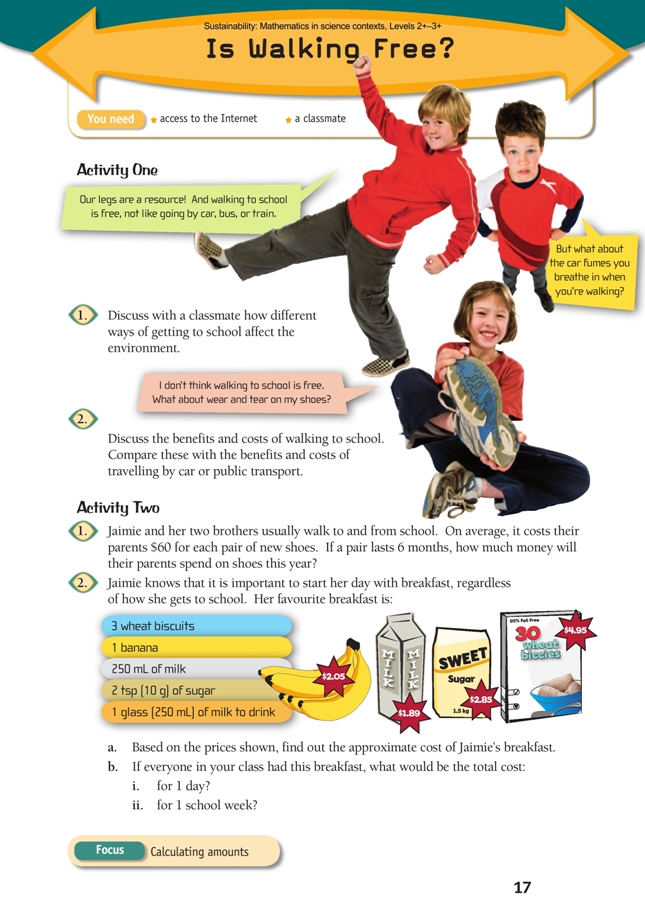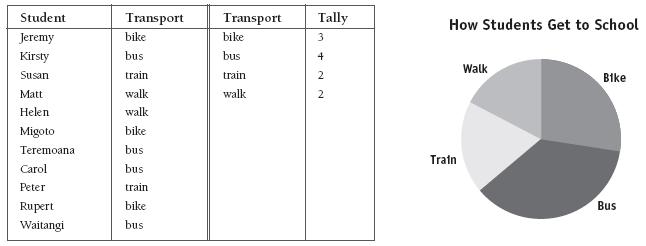This is a level (2+ to 3+) mathematics in science contexts activity from the Figure It Out series.
A PDF of the student activity is included.
Click on the image to enlarge it. Click again to close. Download PDF (1823 KB)
Students will:
- calculate the cost of walking to school
- calculate the cost of a daily breakfast.
Students should discover that:
- the decisions we make often ignore important costs and benefits
- estimates need to be evaluated in context for reasonableness.
a classmate
access to the Internet
Preparation and points to note
You could introduce this activity by having students conduct an impromptu in-class survey on how they get to school. The data could be simply collated and represented like this:
The students could then think about how much it costs for a bicycle, shoes, bus fare, and other related costs (petrol, roads). Evaluating this information will help them develop the key competency thinking.
Points of entry: Mathematics
This activity requires students to make a number of calculations, including multi-part calculations. The students should do these without a calculator, using tidy numbers and other strategies to come up with realistic approximations or estimates.
Students sometimes think that estimating or approximating gives a rough and therefore “wrong” answer. This theory needs teasing out with the help of examples such as the ones in this activity. Take the milk that Jaimie uses: 500 mL from a 1 L carton costing $1.89 comes out at 94.5 cents. Is this the “right” answer? No, because Jaimie doesn’t measure the milk that goes onto her cereal, she simply tips on about a quarter of a carton. Also, the price of the milk is unlikely to be stable; it may vary considerably according to brand, special prices, place of purchase, or seasonal price changes. So it’s better to say that Jaimie uses “about half a litre” of milk for breakfast and that the cost of this is “about $1.00” (95 cents, rounded). It is important that students learn to think about the meaning of numbers in the context in which they are used.
Discuss what it is reasonable to assume from a single person’s breakfast. Ask: How realistic do you think this estimate would be? How could we get a better estimate? Could we average the cost of a number of different breakfast choices and base a calculation on this?
Points of entry: Science
As the speech bubble in the students’ book says, legs are a resource. But they are not exactly free: they need to be suitably looked after (hence footwear) and energised (hence breakfasts and other food), regardless of whether or not students walk to school. Of course, those who walk some distance to school will wear out their shoes at a faster rate and burn up additional breakfast kilojoules.
Every choice has costs and benefi ts. The process (often subconscious) of weighing these is known as a cost–benefi t analysis. It can be diffi cult to do this analysis honestly because we are often trying to justify the decision that we want to make! A student who wants to get a ride to school will emphasise the benefi ts (faster, drier, easier) and minimise the costs (parent time, car, health). Ask your students to do a more detailed cost–benefi t analysis on walking than they are asked to do in the activity. Can you reach a consensus decision? If not, why not? (It will probably come down to different values.)
Reinforce the idea that science is about justifying decisions with evidence. Encourage the students to back up any viewpoints or opinions with facts.
Before leaving this activity, bring your students back to the question posed by the title: Is Walking Free? The activity is not suggesting that only those who walk to school need shoes and breakfast!
Answers
Activity One
1. Discussion will vary. Comments are likely to include reference to pollution, the number of cars on the road, the benefits of using public transport, health and other benefits of walking.
2. Discussion will vary. Comments on walking are likely to include health benefits (and possible adverse effects from exposure to fumes, depending on location and route), saving money on transport, good and bad aspects of the time it takes to walk, possible costs of extra clothing/
shoes. Comments on the benefits of car or public transport may include a saving on time, protection from weather, or convenience. Cost factors may involve comparing costs of a car (including parking fees or savings by car pooling) with that for public transport.
Activity Two
1. $360 (3 people x $60 x 2 pairs a year). (If instead they each rode the bus for $1 each way, they
would spend about $1,200 on bus fares [3 people x $1 each way x 200 school days] and would still need at least 1 pair of shoes each.)
2. a. Based on the costs given and using rounding, the approximate cost of 1 breakfast would
be $1.90 (rounded costs: 3 wheat biscuits 50 cents, 10 g sugar 2 cents, 1 banana 40 cents,
milk $1.00).
b. i.–ii. Answers will depend on the number of students in your class. (For a class of 25 students,
1 day = $35; 1 week = $175.)

